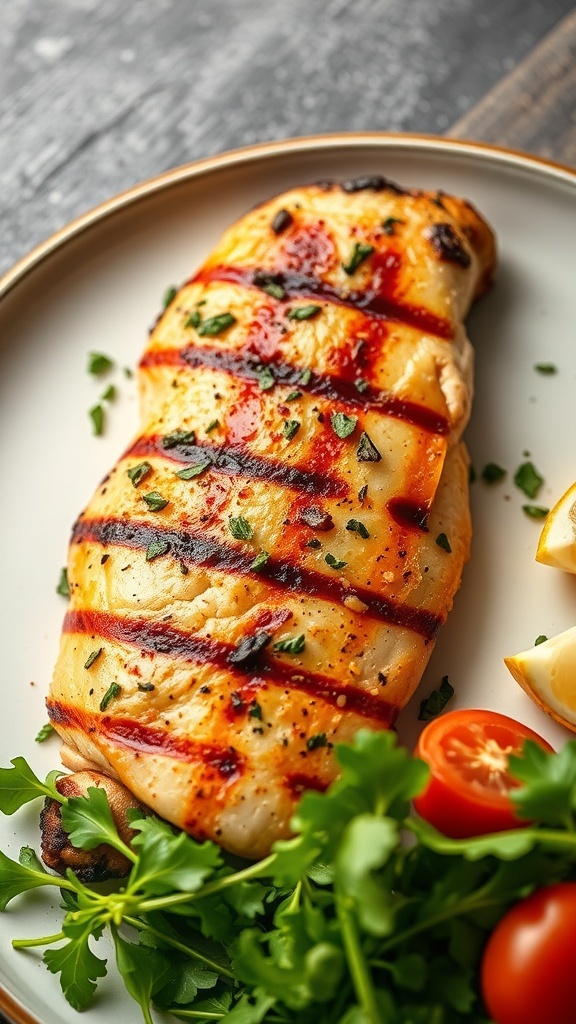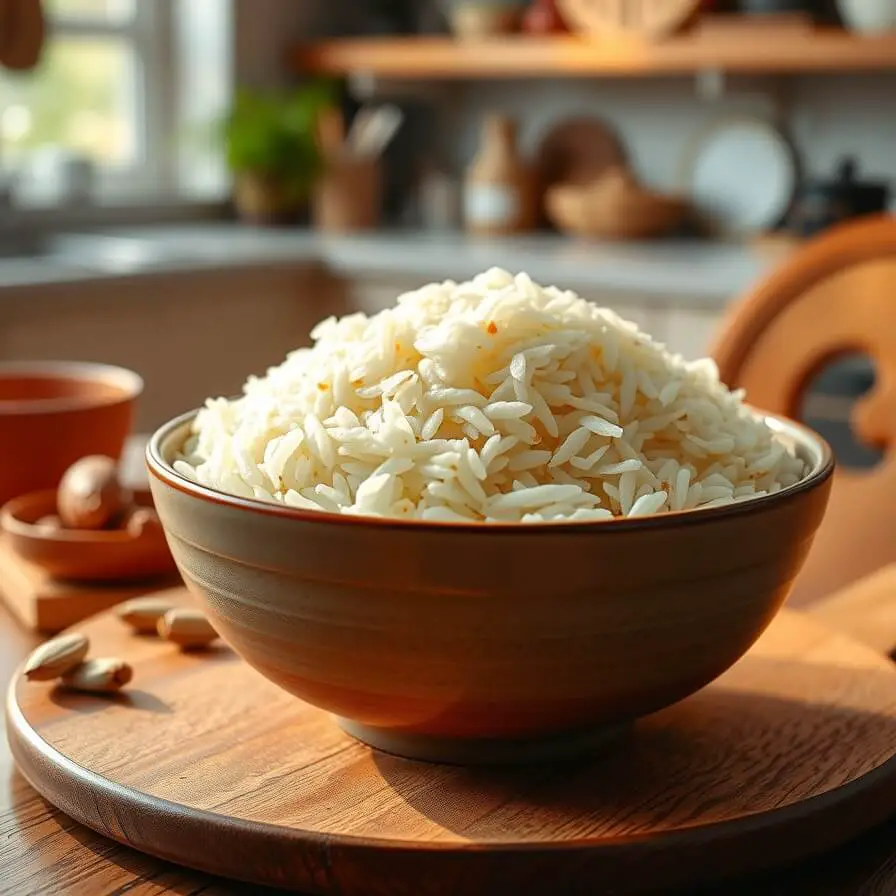
I always say that the simplest recipes are the ones that reveal the most about a cook, and basmati rice is the perfect example. Anyone can boil rice, yes—but perfectly fluffy, fragrant, long-grain basmati? That takes a little intuition, a little patience, and a little love.
I grew up watching this rice simmering on the stove during family gatherings, its aroma drifting through the kitchen long before dinner was served. It didn’t matter what else was on the menu—curries, grilled chicken, lentils—the rice was treated like the quiet star holding the entire meal together.
But the funny thing is, I didn’t actually learn how to cook basmati rice properly the first few times. Mine turned mushy or stuck together like a confused little rice ball. It wasn’t until I paid attention to my aunt’s simple method—washing, soaking, and letting the rice steam slowly—that everything finally clicked.
This recipe is the one I now share whenever someone asks, “How do you get your rice so fluffy?” It’s simple, it’s dependable, and it’s the method I come back to when I want a bowl of perfect basmati rice without overthinking it.
Why I Love This Recipe
There are a hundred ways to make rice, but this method has never let me down. What makes it truly special is how achievable it is—you don’t need a rice cooker, fancy stock, or anything complicated. Just basmati, water, and a bit of technique.
I love that this recipe gives you grains that stay separate yet tender, with that signature basmati aroma that instantly makes the kitchen feel warmer. It’s the kind of recipe that elevates absolutely any meal, even when the rest of the plate is simple.
Another thing I adore about this recipe is its adaptability. Whether you want plain rice for a saucy curry or lightly seasoned rice for grilled meats, this method works as a foundation. It’s like learning one reliable technique and being able to dress it up however you want.
Most of all, this recipe is special because it brings consistency. There’s something comforting about knowing that when life feels chaotic, I can still make a perfect pot of rice that turns out exactly how I want it.
Ingredients for Basmati Rice
Basmati rice doesn’t need much to shine—its fragrance and texture are already naturally beautiful. But understanding the ingredients (even when there are only a few) helps the recipe turn out better.
You’ll need high-quality basmati rice. Not all basmati is the same, so choose one labeled “extra long grain” if you can. The longer the grain, the fluffier your final rice. This recipe is based on using raw, uncooked basmati that has not been parboiled.
You also need clean water. I know that sounds obvious, but if your tap water has a strong taste, filtered water can actually make a difference. The flavor of plain rice is very delicate, so the water does matter.
A little salt is optional but recommended. I add just enough to help bring out its natural nuttiness without making the rice taste salty.
Some people add oil or butter, but I prefer leaving it pure. If you ever want to add spices, herbs, or aromatics later, this plain base makes it really easy to adapt.
How Much Time Will You Need?
Making basmati rice isn’t time-consuming, but it rewards patience. You need about 5 minutes to rinse and soak, though soaking can range between 10 and 20 minutes depending on how fluffy you want it. Cooking takes around 12–15 minutes on the stovetop, followed by a 5–10 minute resting period.
Altogether, you’re looking at roughly 25–35 minutes from start to finish. Not long at all for rice that turns out beautifully every time.
How to Make This Basmati Rice
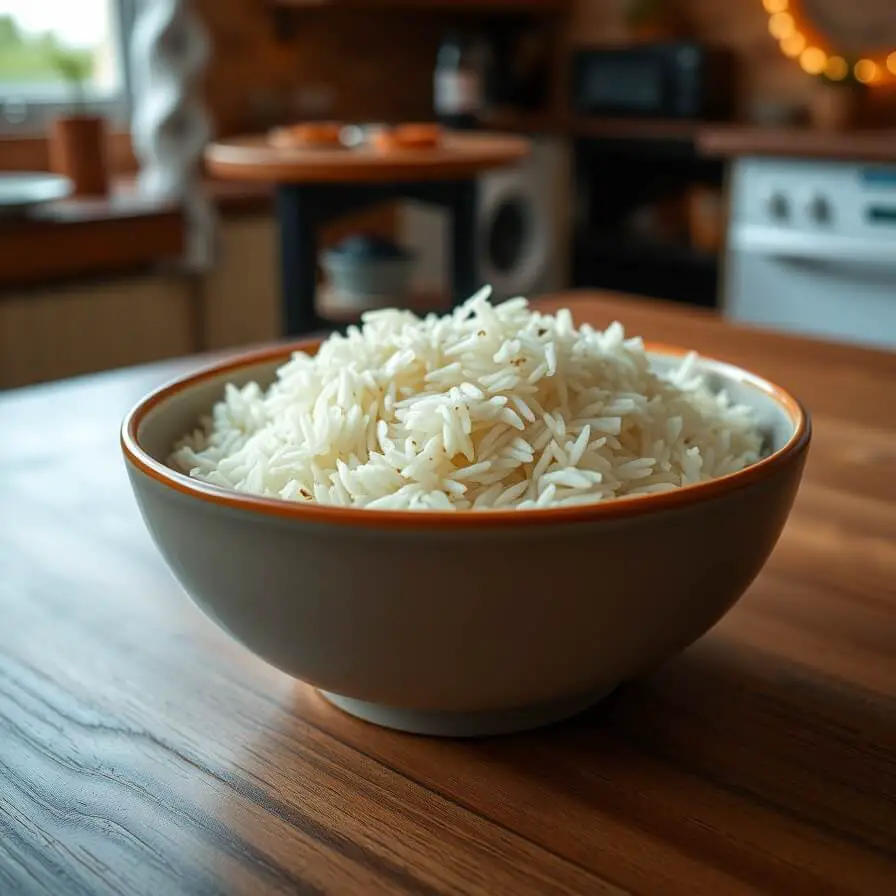
Step – 1: Rinse the Rice
Place the basmati rice into a bowl or fine strainer and run cool water over it. Use your hands to gently swirl the grains. The water will turn cloudy at first—that’s the surface starch. Keep rinsing until the water runs clear. This simple step prevents stickiness later.
Step – 2: Soak the Rice
Transfer the cleaned rice to a bowl and cover it with water. Let it soak for at least 10 minutes, but 20 minutes is even better if you want extra-long, fluffier grains. Soaking allows the grains to absorb moisture evenly, which helps them stay long and separate.
Step – 3: Measure Water and Add to Pot
Drain the soaked rice and place it into a medium-sized saucepan. Add water using a 1:1.5 rice-to-water ratio (for example, 1 cup rice to 1.5 cups water). This ratio works best for stovetop cooking and prevents mushiness.
Step – 4: Add Salt
Sprinkle in a small pinch of salt. Stir gently once to distribute the rice evenly in the pot.
Step – 5: Bring to a Boil
Place the pot on the stove over medium heat and let the water come to a gentle boil. Don’t stir while it heats.
Step – 6: Simmer and Cover
As soon as the water begins to bubble, reduce the heat to low and cover the pot with a tight-fitting lid. Allow it to simmer gently. This slow steaming is what gives basmati rice its signature texture.
Step – 7: Cook Without Lifting the Lid
Let the rice cook undisturbed for 12–15 minutes. Lifting the lid releases steam and slows down the cooking process, so resist the temptation.
Step – 8: Turn Off Heat and Rest
Once the rice has absorbed all the water, turn off the heat. Keep the lid on and let it rest for another 5–10 minutes. This step allows the steam to finish the job and prevents sticky rice.
Step – 9: Fluff and Serve
Use a fork—not a spoon—to gently fluff the rice. This separates the grains without crushing them. Serve warm with your favorite dishes.
Substitutions
If you don’t have basmati rice, there are several alternatives, though each brings a slightly different texture.
You can use jasmine rice, which is also long grain but naturally more fragrant and slightly sticky. It won’t give the same elongated grains as basmati, but it cooks similarly and works beautifully for everyday meals.
Long-grain white rice is another substitute if basmati isn’t available. The flavor is milder and less aromatic, but the fluffy texture is still achievable.
Some cooks like to replace water with chicken or vegetable broth for added flavor. This works well, especially if you’re pairing the rice with grilled or roasted dishes. Just be mindful that broth may contain salt, so adjust accordingly.
A splash of oil or butter can also be added for richer grains that stay even more separate. I use butter when serving rice with roasted meats or Middle Eastern dishes.
Best Side Dish of Basmati Rice
Basmati rice is wonderfully versatile, which makes pairing it fun. Here are three options that truly elevate your meal:
– Chicken curry: The richness of the curry melts beautifully into the fluffy rice.
– Lentil dal: A simple, comforting pairing that balances texture and flavor perfectly.
– Grilled vegetables: Light, smoky vegetables bring freshness to the delicate grains.
These pairings make the rice feel even more satisfying and complete.
Serving and Presentation Tips
There’s something incredibly satisfying about serving a bowl of basmati rice that looks as good as it tastes. Presentation matters, especially with a dish this simple—because when the grains are perfectly long, fluffy, and separate, they almost deserve to be shown off.
One thing I love to do is gently mound the rice using a wide spoon, letting it fall naturally so the grains don’t clump. Sometimes I’ll drizzle a bit of ghee on top for shine or sprinkle a few toasted cumin seeds when I want a subtle aroma. If I’m serving guests, I’ll spoon the rice into a shallow bowl or platter instead of a deep one—the grains look more elegant when they aren’t hidden.
And here’s a little hook: the easiest way to elevate a basic pot of rice is to add a finishing touch. A scattering of chopped cilantro or a light squeeze of lemon brightens the entire dish without overpowering it.
Tips and Tricks to Make This Recipe More Better
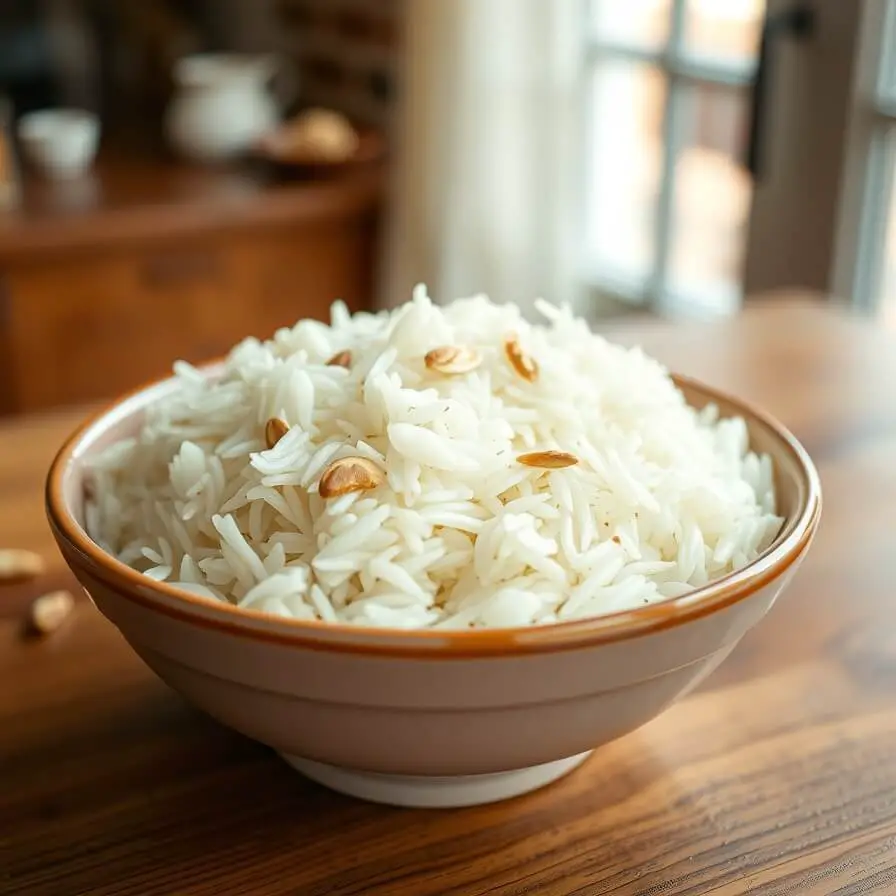
Here’s a truth I learned the hard way: rice doesn’t forgive shortcuts. But once you understand its personality, it becomes one of the most dependable dishes in your kitchen.
One of my go-to tips is always to soak the rice. Even a short soak helps elongate the grains and prevents breakage during cooking. Another trick is not stirring after the water begins to boil—stirring breaks grains and releases starch, which leads to stickiness.
I also find that using a heavy-bottomed pot makes a huge difference. Thin pots heat unevenly and create hot spots that scorch the bottom layer of rice. A tight-fitting lid is equally important because steam is what cooks the rice gently and evenly.
If you want richer flavor, add a small teaspoon of ghee or a bay leaf while cooking. For extra fluffiness, allow the rice to rest after cooking before fluffing—this little pause is what transforms good rice into perfect rice.
Common Mistakes to Avoid
I’ve made every rice mistake you can imagine, and they always seem small until you uncover a pot of mush or burned grains. Avoiding these errors keeps the rice light, fluffy, and fragrant.
One mistake is skipping the rinse. When the rice isn’t washed thoroughly, too much starch stays on the grains, turning the final texture sticky. Another common mistake is using too much water. Basmati is long-grain and delicate; it doesn’t need the same amount of water that medium-grain varieties require.
Stirring the rice during cooking is another big one—this breaks the grains and activates the starch. And finally, lifting the lid too early. Every time you peek, steam escapes, slowing down the cooking process and causing uneven texture.
How to Store It
Storing basmati rice properly keeps it tasting fresh even after a day or two. Once the rice has cooled to room temperature, transfer it to an airtight container. Refrigerated rice stays good for up to four days.
If you want to reheat it, sprinkle a little water over the rice and cover it with a plate or lid before microwaving. This helps replicate steam and keeps the rice soft. For stovetop reheating, add a splash of water, cover the pot, and warm on low heat until the rice is fluffy again.
FAQ
Can I skip soaking the rice?
You can, but the grains won’t be as long or fluffy. Soaking helps the rice absorb moisture evenly.
Why does my rice come out mushy?
Most likely too much water or stirring during cooking. Stick to the right ratio and avoid lifting the lid.
Can I use broth instead of water?
Yes, broth adds great flavor, especially for savory meals, but adjust the salt accordingly.
Can I double the recipe?
Absolutely. Just keep the rice-to-water ratio the same and use a larger pot.
Does this method work in a rice cooker?
Yes. Follow the same rinse and soak steps, then cook according to your rice cooker’s settings.
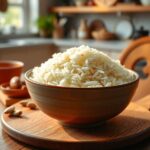
Basmati Rice Recipe
- Total Time: 25 minutes
- Yield: 3–4 1x
- Diet: Gluten Free
Description
This basmati rice recipe gives you consistently fluffy, aromatic, perfectly long grains every single time. It’s a simple stovetop method that doesn’t rely on complicated tools or ingredients—just a careful approach and a few small tricks that make all the difference. Whether you’re pairing it with curries, grilled meats, dal, or vegetables, this rice provides the perfect base that absorbs flavors beautifully without turning sticky. If you’ve ever struggled with mushy or uneven rice, this recipe offers a dependable, beginner-friendly method you can return to again and again. It’s easy, reliable, and elevates even the simplest meal.
Ingredients
- Basmati rice
- Water
- Salt
Instructions
- Rinse the rice thoroughly until the water runs clear.
- Soak the rice for at least 10–20 minutes.
- Add the drained rice to a pot with the measured water and salt.
- Bring to a gentle boil, then reduce heat and cover.
- Cook on low heat until all water is absorbed.
- Turn off heat and rest the rice before fluffing with a fork.
Notes
- Use a heavy pot, avoid stirring, and always rest the rice before serving.
- Prep Time: 10 minutes
- Cook Time: 15 minutes
- Category: Side
- Method: Stovetop
- Cuisine: South Asian
Nutrition
- Serving Size: 3–4
- Calories: 205
- Sugar: 0g
- Sodium: 1mg
- Fat: 1mg
- Saturated Fat: 0g
- Unsaturated Fat: 0.4g
- Trans Fat: 0g
- Carbohydrates: 45g
- Fiber: 0.6g
- Protein: 4g
- Cholesterol: 0mg










